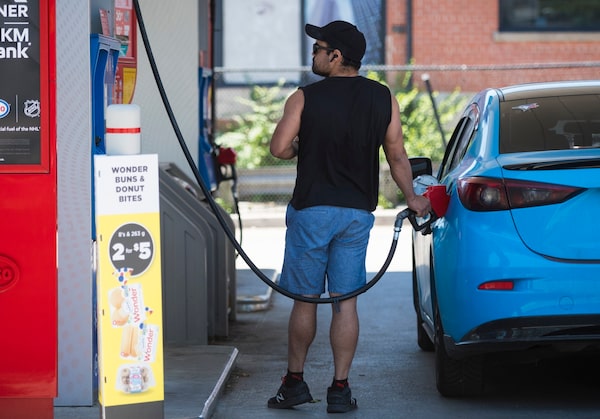
A commuter pumps gas into their vehicle at a Esso gas station in Toronto on June 15, 2021.Tijana Martin/The Canadian Press
Canadian inflation slowed in July as consumers paid less for gasoline, but prices for many everyday items grew at faster rates, showing how cost-of-living pressures remain a threat to household budgets.
The Consumer Price Index (CPI) rose 7.6 per cent in July from a year earlier, Statistics Canada said Tuesday. That was down from 8.1 per cent in June, the highest inflation rate in nearly 40 years. On a monthly basis, the change in CPI was the smallest since December, 2021.
Gas prices, while still much higher than last year, fell 9.2 per cent in July from June, making the biggest contribution to lower headline inflation. August is bringing more relief at the pump, too: The national average price for regular unleaded gas was $1.73 a litre on Monday, down 9 per cent from the average retail price in July, according to data from Kalibrate Technologies.
Other details in Tuesday’s report were less encouraging. Groceries rose at an annual rate of 9.9 per cent, up from 9.4 per cent in June. Rents increased 4.9 per cent, the most since 1989. And natural gas prices jumped by a whopping 43 per cent, which Statscan attributed in part to the Ontario Energy Board’s approval of rate increases.
Inflation slowed to 7.6% in July. Here’s what that means for the cost of living in Canada
Moreover, the average of the Bank of Canada’s core measures of annual inflation – which strip out volatile price changes – rose to 5.3 per cent from an upwardly revised 5.2 per cent in June. In response, financial analysts said the central bank is certain to keep hiking interest rates to tamp down consumer price growth.
“It’s great that headline inflation is moving in the right direction as energy prices ease,” said Leslie Preston, managing director at TD Economics. “But there was very little cooling in core inflation. And I think it’s a reminder that the Bank of Canada needs to continue to raise rates to rein in inflationary pressures.”
Similar to Canada, the United States reported a slower pace of inflation last week, with the annual rate ebbing to 8.5 per cent in July from 9.1 per cent in June. In addition to gasoline, several key commodities – including wheat and lumber – have tumbled this summer, as have shipping rates, offering some modicum of relief to companies and households.
At the same time, inflation remains uncomfortably high and could take years before returning to desired levels. The Bank of Canada projected in July that inflation won’t return sustainably to its 2-per-cent target until late 2024. Financial analysts expect the bank to make another hefty rate hike in September, perhaps by half or three-quarters of a percentage point. The bank’s policy rate is now at 2.5 per cent, the highest since 2008.
Governor Tiff Macklem suggested Tuesday the central bank’s campaign to raise interest rates is far from over. “We know our job is not done yet – it won’t be done until inflation gets back to the two per cent target,” he wrote in an op-ed published in the National Post.
Central bankers are trying to engineer a “soft landing,” in which they hike interest rates to slow demand and tame inflation, but without sending the economy into a recession. “The path to this soft landing has narrowed,” Mr. Macklem said in July, citing persistently high inflation that “requires stronger action now” via large rate hikes.
Canada’s economic growth has slowed considerably in recent months, while activity in the country’s housing market has plunged amid higher borrowing rates. The odds of a recession are rising, economists say, although Royal Bank of Canada is the sole major lender to predict that outcome by next year.
“I certainly don’t think we’re in a recession at all,” Pedro Antunes, chief economist at the Conference Board of Canada, said in a recent interview. “The reason I think we may avoid a recession is in part because labour markets are still in exceptionally good shape.”
Canada shed jobs in June and July, but with a historically low unemployment rate of 4.9 per cent and roughly one million job vacancies, it suggests employers are struggling to hire enough workers.
With fewer COVID-19 restrictions in place, Canadians are travelling more – and those prices are rising quickly. Airfares jumped 26 per cent in July from June, while accommodation prices were up 48 per cent on an annual basis.
“We had a lot of pandemic restrictions, and really summer 2022 is when a lot of Canadians are taking long-awaited vacations that have probably been delayed multiple times,” Ms. Preston said.
Conversely, as consumers shift their buying away from bulky goods, price growth is starting to moderate for those items. The annual rate of inflation for durable goods slowed to 7 per cent in July from 7.9 per cent in June.
Jean-Paul Lam, an economics professor at the University of Waterloo, said it is premature to say inflation has peaked. He pointed to a range of international factors – the continuing fallout of Russia’s invasion of Ukraine, China’s handling of COVID-19 and lingering supply chain issues – that could drive up future prices.
“Inflation remains a significant problem,” he said. “We’re not out of the woods yet.”
Your time is valuable. Have the Top Business Headlines newsletter conveniently delivered to your inbox in the morning or evening. Sign up today.